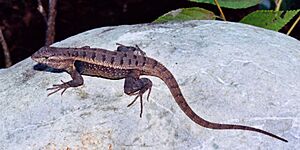Rose-bellied lizard facts for kids
Quick facts for kids Rose-bellied lizard |
|
|---|---|
 |
|
| Conservation status | |
| Scientific classification | |
| Synonyms | |
|
The rose-bellied lizard (Sceloporus variabilis) is a small and colorful lizard. It gets its name from the pink patches on the bellies of the males. These lizards are a type of reptile found in warm, dry places. They live from Central America all the way up to southern Texas.
Contents
Where Does the Rose-Bellied Lizard Live?
You can find the rose-bellied lizard in many places. Its home stretches from southern Texas down to northern Costa Rica. These lizards often prefer dry areas. They like places that are a bit like deserts or have less water.
What Does the Rose-Bellied Lizard Look Like?
The rose-bellied lizard is one of the smaller lizards in its group, called Sceloporus. An adult lizard can grow to be about 54 millimeters (about 2 inches) long, not counting its tail. With a full, unbroken tail, it can reach a total length of about 140 millimeters (about 5.5 inches).
Colors and Patterns
On its back, the rose-bellied lizard is usually tan or olive green. It has two rows of dark brown spots. There are also two yellowish stripes running along each side of its back. Male lizards have darker sides below these stripes.
The belly of the lizard is a dirty white or yellowish color. Male lizards are special because they have a large pink patch on each side of their belly. These pink patches are outlined with dark blue. Males also have a black mark near their armpit area.
Scales and Features
The scales on the lizard's back are rough and spiny. They are also pointed, which helps protect the lizard. There are many of these scales, usually between 58 and 69, from its head to the base of its tail. Male lizards have tiny pores, called femoral pores, on their thighs. These pores are used for scent marking.


